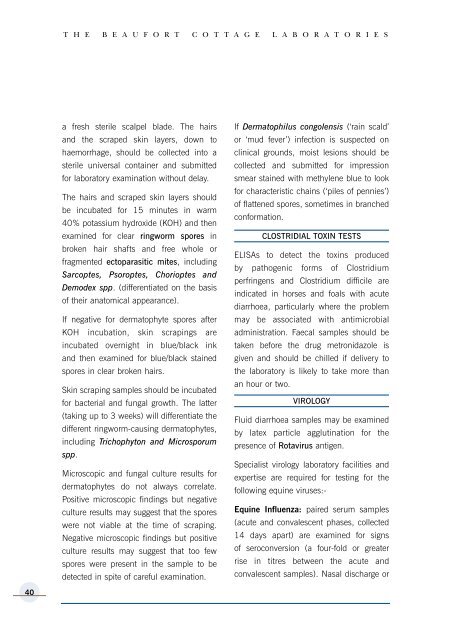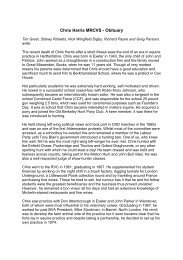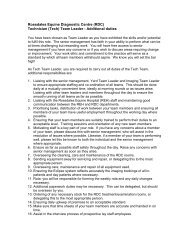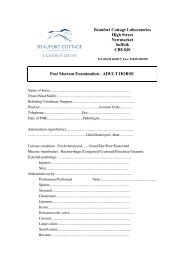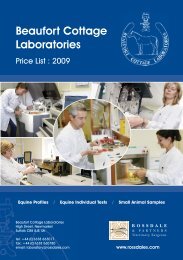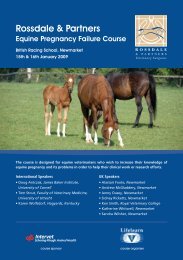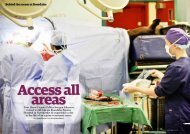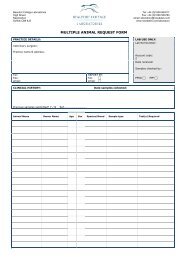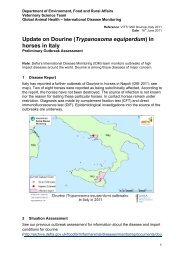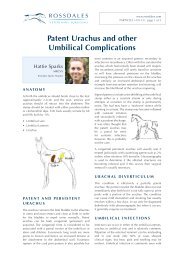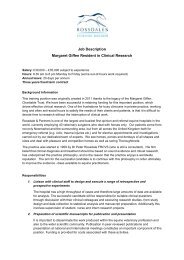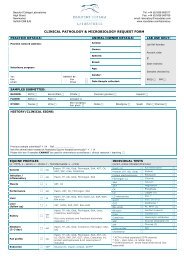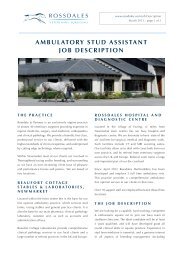EQUINE CLINICAL PATHOLOGY - Rossdale & Partners
EQUINE CLINICAL PATHOLOGY - Rossdale & Partners
EQUINE CLINICAL PATHOLOGY - Rossdale & Partners
Create successful ePaper yourself
Turn your PDF publications into a flip-book with our unique Google optimized e-Paper software.
T h e B e a u f o r t c o t t a g e l a b o r a t o r i e s<br />
a fresh sterile scalpel blade. The hairs<br />
and the scraped skin layers, down to<br />
haemorrhage, should be collected into a<br />
sterile universal container and submitted<br />
for laboratory examination without delay.<br />
The hairs and scraped skin layers should<br />
be incubated for 15 minutes in warm<br />
40% potassium hydroxide (KOH) and then<br />
examined for clear ringworm spores in<br />
broken hair shafts and free whole or<br />
fragmented ectoparasitic mites, including<br />
Sarcoptes, Psoroptes, Chorioptes and<br />
Demodex spp. (differentiated on the basis<br />
of their anatomical appearance).<br />
If negative for dermatophyte spores after<br />
KOH incubation, skin scrapings are<br />
incubated overnight in blue/black ink<br />
and then examined for blue/black stained<br />
spores in clear broken hairs.<br />
Skin scraping samples should be incubated<br />
for bacterial and fungal growth. The latter<br />
(taking up to 3 weeks) will differentiate the<br />
different ringworm-causing dermatophytes,<br />
including Trichophyton and Microsporum<br />
spp.<br />
Microscopic and fungal culture results for<br />
dermatophytes do not always correlate.<br />
Positive microscopic findings but negative<br />
culture results may suggest that the spores<br />
were not viable at the time of scraping.<br />
Negative microscopic findings but positive<br />
culture results may suggest that too few<br />
spores were present in the sample to be<br />
detected in spite of careful examination.<br />
If Dermatophilus congolensis (‘rain scald’<br />
or ‘mud fever’) infection is suspected on<br />
clinical grounds, moist lesions should be<br />
collected and submitted for impression<br />
smear stained with methylene blue to look<br />
for characteristic chains (‘piles of pennies’)<br />
of flattened spores, sometimes in branched<br />
conformation.<br />
clostridial toxin tests<br />
ELISAs to detect the toxins produced<br />
by pathogenic forms of Clostridium<br />
perfringens and Clostridium difficile are<br />
indicated in horses and foals with acute<br />
diarrhoea, particularly where the problem<br />
may be associated with antimicrobial<br />
administration. Faecal samples should be<br />
taken before the drug metronidazole is<br />
given and should be chilled if delivery to<br />
the laboratory is likely to take more than<br />
an hour or two.<br />
Virology<br />
Fluid diarrhoea samples may be examined<br />
by latex particle agglutination for the<br />
presence of Rotavirus antigen.<br />
Specialist virology laboratory facilities and<br />
expertise are required for testing for the<br />
following equine viruses:-<br />
Equine Influenza: paired serum samples<br />
(acute and convalescent phases, collected<br />
14 days apart) are examined for signs<br />
of seroconversion (a four-fold or greater<br />
rise in titres between the acute and<br />
convalescent samples). Nasal discharge or<br />
40


